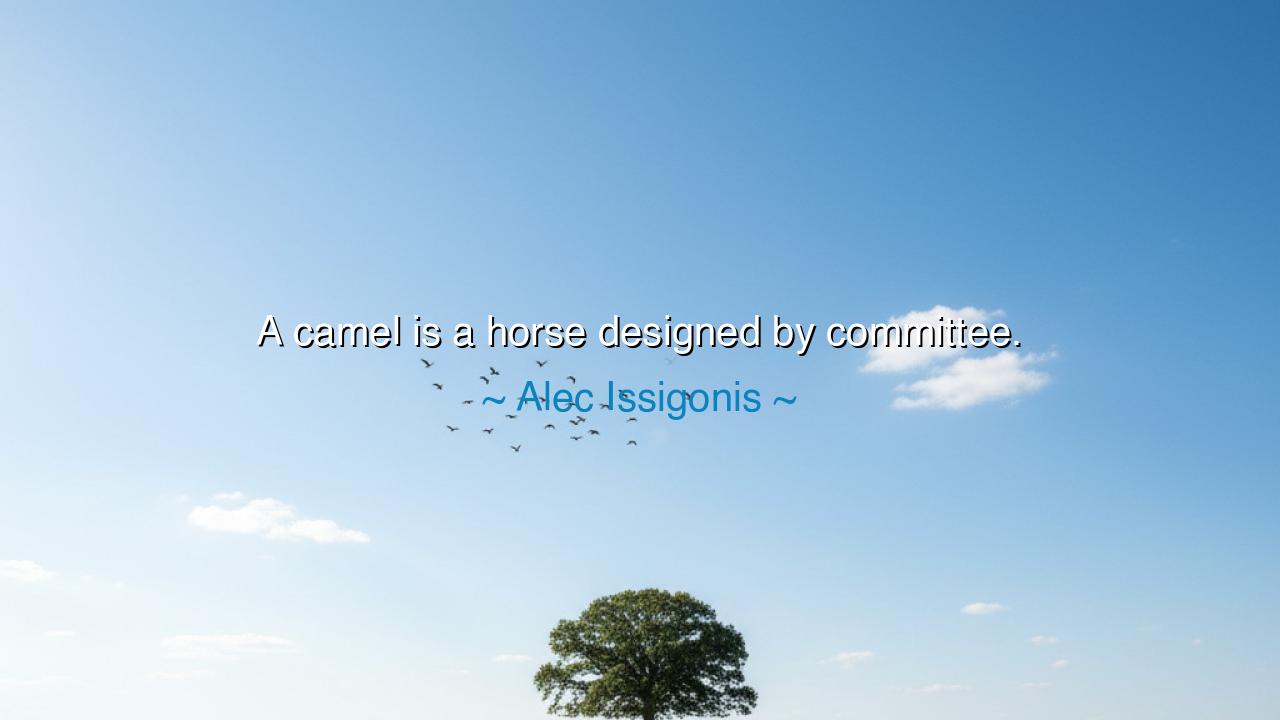
A camel is a horse designed by committee.






“A camel is a horse designed by committee.” — Alec Issigonis
Thus spoke Alec Issigonis, the brilliant engineer and creator of the legendary Mini, whose wit concealed a deep truth about the nature of creation and human endeavor. When he said, “A camel is a horse designed by committee,” he was not mocking the camel, noble creature of the desert, but warning of the perils that arise when too many minds pull in too many directions. He meant that when vision is divided among the uncertain and the fearful, when purpose is diluted by compromise and caution, the result may function — but it will never inspire. For where unity of vision creates beauty, confusion of intention breeds mediocrity.
The origin of this quote lies in the world of industrial design, where Issigonis made his mark as one of the most daring inventors of the twentieth century. He was a man who trusted intuition, not bureaucracy; imagination, not endless discussion. As the chief designer of the Morris Mini Minor in 1959, Issigonis defied convention. Where others sought grandeur, he sought simplicity — a small car, efficient, elegant, and ingenious. His work became a revolution. And yet, he often clashed with committees, with the managers and executives who wanted to “improve” his ideas by dividing them among many hands. It was from this battle of creativity against conformity that his famous saying was born.
The camel, in Issigonis’s metaphor, is no failure — it lives, it endures, it survives the desert’s cruelty. But it is not what the horse was meant to be: swift, graceful, and born of purpose. The camel is what happens when a single, inspired idea is broken into pieces, reshaped by too many opinions, and stitched together without soul. It moves, but without harmony. It stands, but without grace. So too, Issigonis teaches, does every work of art, invention, or dream falter when vision is surrendered to the multitude. True creation requires a singular hand and a courageous heart.
History offers many mirrors to this wisdom. Consider the architects of the ancient Parthenon, who worked under a single guiding principle — the pursuit of harmony. Each column, each ratio, each stone reflected one vision. The result endures as perfection in marble. Yet when the Tower of Babel was raised, many tongues, many wills, and many vanities clashed, and the structure collapsed before it reached the heavens. The moral is clear: where there is unity of purpose, even the impossible can be achieved; where there is division, even the possible falls apart.
Issigonis’s words are not merely about design — they are about leadership, creativity, and the human spirit. In every age, the world needs visionaries — those who dare to see clearly when others see only confusion. But the visionary must also defend their vision against the erosion of compromise. The committee, in its fear of risk, seeks safety in consensus, but consensus rarely gives birth to greatness. The boldest ideas often sound foolish to the cautious, and so they are smoothed, softened, and subdued until nothing daring remains. The world gains another camel — useful, yes, but never magnificent.
The lesson is this: do not let your vision be carved apart by the timid voices of doubt. Listen, yes — for wisdom may come from many — but never surrender the core of your idea. Protect its heart. For if you seek to please all, you will please none; if you aim to avoid every flaw, you will lose every spark of brilliance. The greatest works of art, invention, and progress have always borne the fingerprints of one uncompromising mind, one soul aflame with purpose.
So remember the teaching of Alec Issigonis: “A camel is a horse designed by committee.” It is a parable for all who create, lead, or dream. Whether you are building a bridge, writing a story, or shaping your life, let your purpose remain clear and undivided. Accept guidance, but guard your vision. The world already has many camels — serviceable, safe, and ordinary. What it needs are horses: swift, daring, and alive with grace. Be the one who designs not by fear, but by faith — not by committee, but by conviction.






AAdministratorAdministrator
Welcome, honored guests. Please leave a comment, we will respond soon